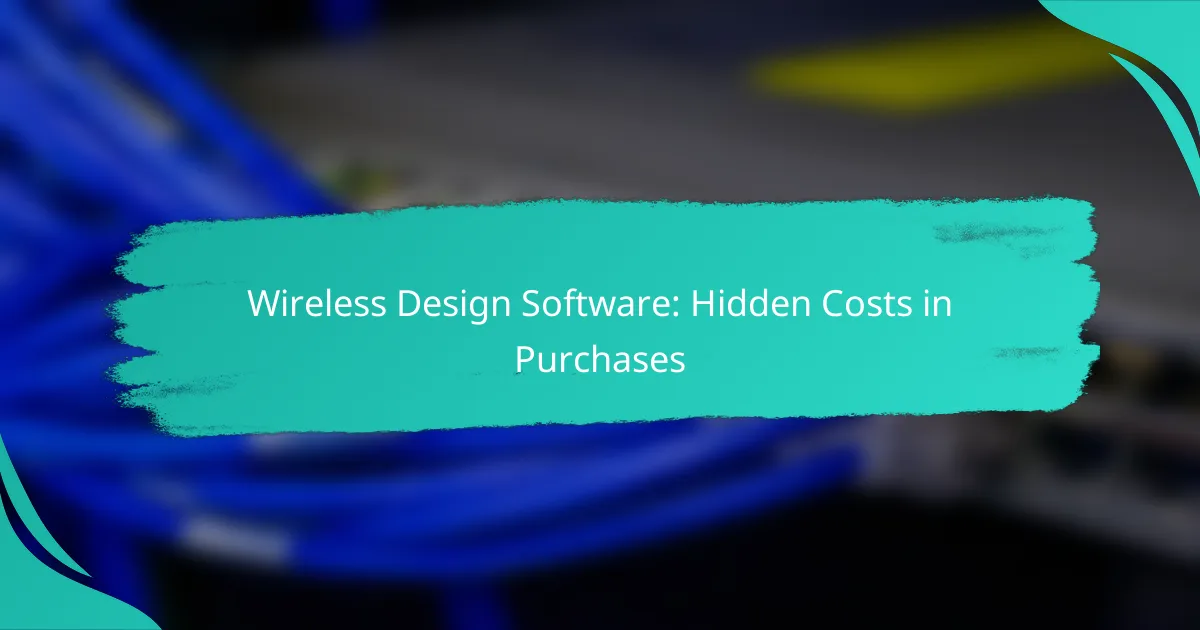When investing in wireless design software, it’s crucial to recognize that the initial purchase price is just the tip of the iceberg. Hidden costs such as licensing fees, training, maintenance, and integration challenges can quickly escalate your budget. By thoroughly evaluating these ongoing expenses and potential inefficiencies, you can make a more informed decision that aligns with your long-term needs and financial goals.

What are the hidden costs of wireless design software in Australia?
The hidden costs of wireless design software in Australia can significantly impact your overall budget. Beyond the initial purchase price, factors such as licensing fees, training expenses, maintenance, integration challenges, and upgrade costs can add up quickly.
Licensing fees
Licensing fees are often a recurring expense that can vary widely based on the software provider and the features included. In Australia, these fees may be structured as annual subscriptions or one-time payments, with costs ranging from a few hundred to several thousand Australian dollars per year.
It’s essential to read the fine print regarding user limits and additional charges for extra features, as these can lead to unexpected expenses over time.
Training expenses
Training expenses can be a significant hidden cost when implementing wireless design software. Depending on the complexity of the software, you may need to invest in formal training sessions or workshops, which can cost anywhere from AUD 500 to AUD 2,000 per employee.
Consider online tutorials or vendor-provided resources as cost-effective alternatives to formal training, but ensure they adequately cover the necessary skills for your team.
Maintenance and support costs
Maintenance and support costs are crucial for ensuring your wireless design software runs smoothly. Many providers charge an annual fee for technical support and software updates, which can range from 15% to 25% of the software’s initial cost.
Evaluate the level of support offered, as cheaper options may result in longer response times or limited assistance, leading to potential downtime.
Integration challenges
Integration challenges can arise when trying to connect wireless design software with existing systems. These challenges may require additional resources for customization or troubleshooting, potentially costing thousands of dollars.
Before purchasing, assess how well the software integrates with your current tools and consider the potential costs of hiring external consultants if needed.
Upgrade costs
Upgrade costs can catch users off guard, especially if the software provider frequently releases new versions. These upgrades may require additional fees, which can be a few hundred to several thousand dollars, depending on the extent of the changes.
Stay informed about the upgrade policies of your chosen software and budget for these costs to avoid surprises in the future.

How to identify hidden costs in wireless design software?
Identifying hidden costs in wireless design software involves looking beyond the initial purchase price to consider ongoing expenses and potential inefficiencies. This includes evaluating licensing fees, maintenance costs, and the impact of software limitations on productivity.
Conduct a total cost of ownership analysis
A total cost of ownership (TCO) analysis helps you assess all costs associated with wireless design software over its lifecycle. This includes not only the purchase price but also expenses related to training, support, and upgrades.
To conduct a TCO analysis, list all potential costs, such as:
- Initial purchase or subscription fees
- Annual maintenance and support costs
- Training expenses for staff
- Costs associated with downtime or inefficiencies
By quantifying these factors, you can make a more informed decision about the software’s true financial impact.
Review user feedback and case studies
User feedback and case studies provide valuable insights into the real-world performance of wireless design software. They can reveal hidden costs related to usability, customer support, and integration with existing systems.
Look for reviews on reputable platforms and case studies from similar organizations. Pay attention to comments about:
- Ease of use and learning curve
- Quality of customer support
- Integration challenges with other tools
This information can highlight potential pitfalls and help you gauge whether the software will meet your needs without incurring unexpected expenses.

What are the best practices for purchasing wireless design software?
To effectively purchase wireless design software, focus on evaluating multiple vendors, negotiating pricing and terms, and considering long-term scalability. These practices help ensure that you select a solution that meets your needs while minimizing hidden costs.
Evaluate multiple vendors
Start by researching various vendors to compare features, pricing, and customer support. Look for software that aligns with your specific requirements, such as compatibility with existing systems and user-friendliness.
Request demos or trial versions to assess usability and functionality. This hands-on experience can reveal differences that may not be apparent through marketing materials alone.
Negotiate pricing and terms
Once you have shortlisted vendors, engage in discussions to negotiate pricing and contract terms. Many companies are open to adjusting their offers, especially for long-term commitments or bulk purchases.
Be clear about your budget constraints and ask about potential discounts, payment plans, or additional services included in the package. Understanding the total cost of ownership, including maintenance and support, is crucial for making an informed decision.
Consider long-term scalability
When selecting wireless design software, consider how well it can scale with your future needs. Choose a solution that can accommodate growing project sizes or additional features without requiring a complete overhaul.
Evaluate the vendor’s roadmap for updates and new features to ensure that the software will remain relevant as technology evolves. This foresight can save significant costs and effort in the long run.

What are the top wireless design software options available in Australia?
In Australia, several wireless design software options stand out for their features and usability. These tools cater to various needs, from circuit design to simulation, making them essential for engineers and designers in the field.
Altium Designer
Altium Designer is a comprehensive PCB design software that integrates schematic capture, PCB layout, and design management. It is particularly favored for its user-friendly interface and robust collaboration features, allowing teams to work efficiently on complex projects.
When using Altium Designer, consider its licensing costs, which can range from a few thousand AUD for a standard license to higher amounts for advanced features. Additionally, be aware of potential hidden costs related to training and support, which can add to the overall investment.
Cadence Allegro
Cadence Allegro is a powerful tool for PCB design and analysis, known for its advanced capabilities in handling high-speed designs. It offers extensive libraries and design rule checks that help ensure compliance with industry standards.
While Cadence Allegro is a robust choice, its pricing can be significant, often requiring a substantial budget. Users should also factor in the learning curve associated with the software, which may necessitate additional training resources to maximize its potential.
Keysight ADS
Keysight Advanced Design System (ADS) specializes in RF and microwave design, providing tools for circuit simulation, layout, and electromagnetic analysis. It is particularly useful for engineers working on wireless communication systems and components.
Keysight ADS typically involves a licensing fee that can be considerable, depending on the modules selected. Users should also consider the costs associated with ongoing updates and technical support, as these can impact the total cost of ownership over time.

How can businesses mitigate hidden costs in software purchases?
Businesses can mitigate hidden costs in software purchases by conducting thorough evaluations and establishing clear budget guidelines. This proactive approach helps identify potential expenses beyond the initial price, such as maintenance, training, and integration costs.
Implement a budget review process
Establishing a budget review process is crucial for managing software expenses effectively. This involves regularly assessing both current and projected software costs, including licensing fees, support services, and any additional functionalities that may be required over time.
Consider setting a budget that allows for a contingency of around 10-20% to cover unforeseen expenses. This can help cushion the impact of unexpected costs that often arise during software implementation and maintenance.
Involve key stakeholders in the budget review process to ensure all potential costs are considered. Regular meetings can help keep everyone informed and aligned on spending, which can prevent overspending and miscommunication.
